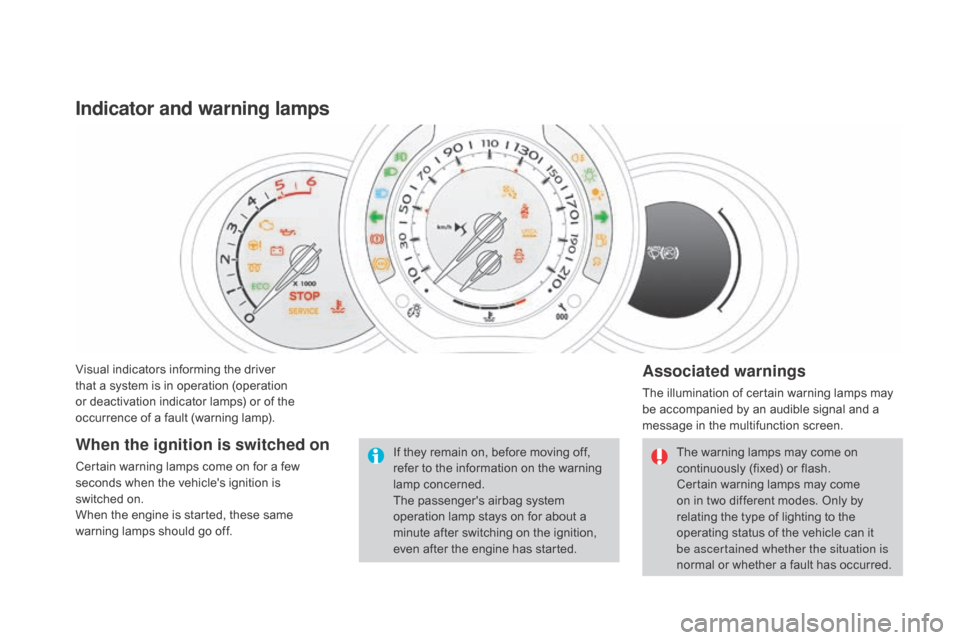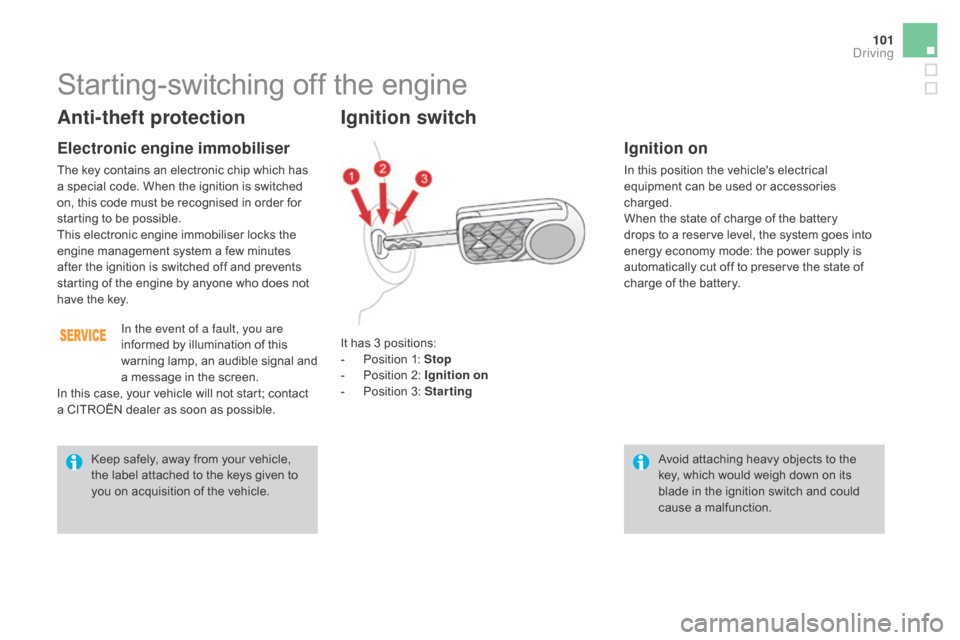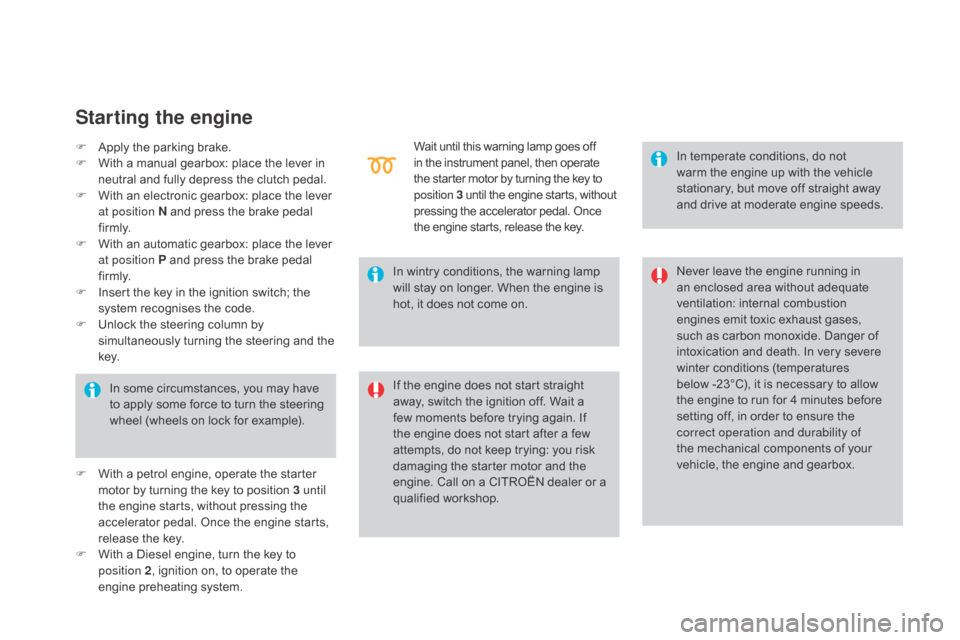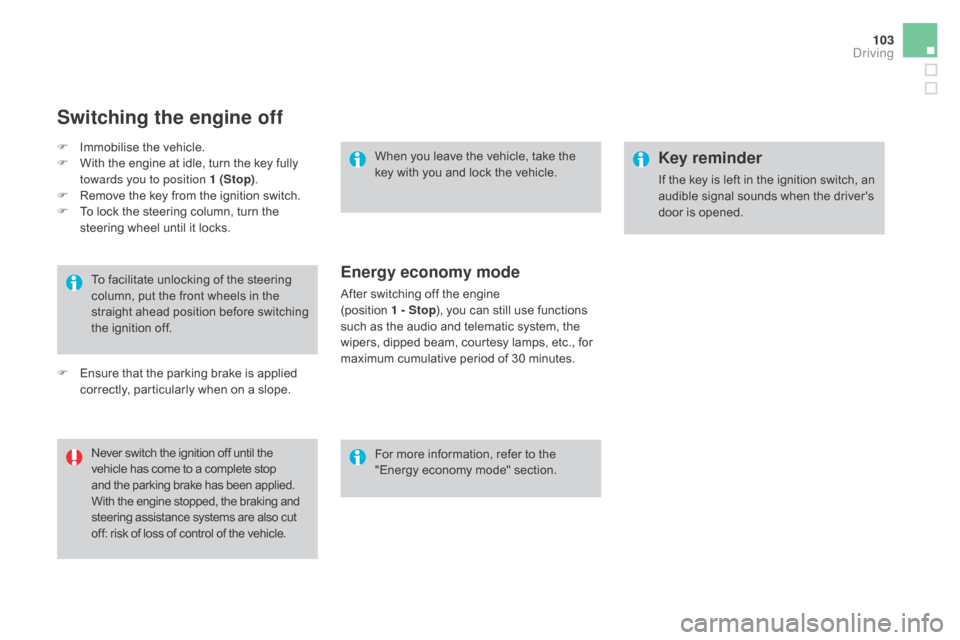ECO mode Citroen DS3 2015 1.G Owner's Manual
[x] Cancel search | Manufacturer: CITROEN, Model Year: 2015, Model line: DS3, Model: Citroen DS3 2015 1.GPages: 415, PDF Size: 11.95 MB
Page 6 of 415

DS3_en_Chap00a_sommaire_ed01-2015
SAFETYPR ACTICAL
InF
ORMATIOnCHILd S AFETY
168 Child seats
171 D
eactivating t he p assenger's f
ront airbag
178
I
SOFIX child seats
14 4 D
irection indicators
14 4 H
azard w
arning lam
ps
14 5
Horn
14 5
E
mergency
or
assistance
c
all
14 6
U
nder-inflation
d
etection
15 0
B
raking
assistance
systems
151
T
rajectory
control
systems
153
A
ctive
City
Brake
157
F
ront seat belts
160
A
irbags 184 F
uel tank
186 M isfuel prevention (Diesel)
187
R
unning out of fuel (Diesel)
188
AdBlue
® additive and SCR
system
(BlueHDi Diesel)
195
T
emporary puncture repair
k
it
200
C
hanging a wheel
207
S
now chains
208
C
hanging
a bu
lb
216
C
hanging
a f
use
223
B
attery
226
E
nergy
economy mode
227
C
hanging a wiper blade
228
T
owing
the vehicle
230
T
owing
a trailer
232
A
dvice on care and
maintenance
234
Accessories
130
L
ighting
c
ontrols
133
A
utomatic
illumination
of
h
eadlamps
13 4 L
ED
daytime
running
lamps
135 H
eadlamp adj
ustment
136
W
iper controls
14 0
C
ourtesy
lamp
141
I
nterior
m
ood
l
ighting
141
B
oot
lamp
008006007
VISIBILITY005
Page 16 of 415

DS3_en_Chap00c_eco-conduite_ed01-2015
Before moving off, if the passenger compartment is too warm, ventilate it by opening the windows and air vents before using the air
c
onditioning.
Above
30 mph (50 km/h), close the windows and leave the air vents
ope
n.
Remember
to make use of equipment that can help keep the temperature
i
n the passenger compartment down (sunroof and window blinds...).
Switch
off the air conditioning, unless it has automatic regulation, as
s
oon as the desired temperature is attained.
Switch
off the demisting and defrosting controls, if not automatic.
Switch
off the heated seat as soon as possible.
Switch
off the headlamps and front foglamps when the level of light
d
oes not require their use.
Avoid
running the engine before moving off, particularly in winter; your
v
ehicle will warm up much faster while driving.
Eco-driving
Eco-driving is a range of everyday practices that allow the motorist to optimise their fuel consumption and CO2 emissions.
Optimise the use of your gearbox
With a manual gearbox, move off gently and change up without waiting. During acceleration change up early.
With
an automatic or electronic gearbox, give preference to automatic
m
ode and avoid pressing the accelerator pedal heavily or suddenly.
The
gear shift indicator invites you engage the most suitable gear: as
s
oon as the indication is displayed in the instrument panel, follow it
s
traight away.
For
vehicles fitted with an electronic or automatic gearbox, this
i
ndicator appears only in manual mode.
drive smoothly
Maintain a safe distance between vehicles, use engine braking rather than the brake pedal, and press the accelerator progressively. These
p
ractices contribute towards a reduction in fuel consumption and CO
2
emissions
and
also
helps
reduce
the
background
traffic
noise.
Control the use of your electrical
equipment
If your vehicle has cruise control, make use of the system at speeds a bove 25 mph (40 km/h) when the traffic is flowing well.As
a passenger, if you avoid connecting your multimedia devices
(
film, music, video game...), you will contribute towards limiting the c
onsumption of electrical energy, and so of fuel.
Disconnect your portable devices before leaving the vehicle.
Page 24 of 415

DS3_en_Chap01_controle-de-marche_ed01-2015
Visual indicators informing the driver that a system is in operation (operation
o
r deactivation indicator lamps) or of the
o
ccurrence of a fault (warning lamp).
Indicator and warning lamps
Associated warnings
The illumination of certain warning lamps may be accompanied by an audible signal and a
m
essage in the multifunction screen.
The
warning lamps may come on
c
ontinuously (fixed) or flash.
Certain
warning lamps may come
o
n in two different modes. Only by
r
elating the type of lighting to the
o
perating status of the vehicle can it
b
e ascertained whether the situation is
normal
or whether a fault has occurred.
If
they
remain
on,
before
moving
off,
r
efer
to
the
information
on
the
warning
lam
p
c
oncerned.
The
passenger's
airbag
system
o
peration
lamp
stays
on
for
about
a
m
inute
after
switching
on
the
ignition,
e
ven
after
the
engine
has
started.
When the ignition is switched on
Certain warning lamps come on for a few s econds when the vehicle's ignition is
switched
on.
When
the engine is started, these same
w
arning lamps should go off.
Page 26 of 415

DS3_en_Chap01_controle-de-marche_ed01-2015
Warning/indicator lampis on Cause Action / Observations
di
esel engine
pre-heating fixed.
The
key is at position 2 (ignition on) in
t
he ignition switch.Wait
until the warning lamp goes off before starting.
The
period of illumination of the warning lamp is
d
etermined by the climatic conditions (up to about
t
hirty seconds in extreme climatic conditions).
If
the engine does not start, switch the ignition off and
t
hen on, wait until the warning lamp goes off again,
t
hen start the engine.
Parking brake fixed. The
parking brake is applied or not
p
roperly
r
eleased.Release
the parking brake to switch off the warning
l
amp, keeping your foot on the brake pedal.
Observe
the safety recommendations.
For
more information on the parking brake, refer to the
c
orresponding
s
ection.
Stop & Star t fixed. When
the vehicle stops (red lights,
t
raffic jams, ...) the Stop & Start system
h
as put the engine into STOP mode.The
warning lamp goes off and the engine restarts
a
utomatically in START mode, as soon as you want to
m
ove off.
flashes for a few
seconds,
then goes
o
f f.STOP
mode is temporarily
u
navailable.
or
START
mode is invoked
au
tomatically.For
more information on special cases with STOP
m
ode and START mode, refer to the "Stop & Start"
s
ection.
Page 50 of 415

DS3_en_Chap01_controle-de-marche_ed01-2015
Display configuration
Once this menu has been selected, you can gain access to the following settings:
-
b
rightness-video
s
etting,
-
d
ate and time setting,
-
s
election of units.
Once
the fuel consumption units have
b
een changed to mpg, the information
i
n the screen relating to speed and
d
istance also changes to mph and
mil
es
re
spectively. As
a safety measure, configuration by
t
he driver of the multifunction screen
s
hould only be done when stationary.
Choice of language
Once this menu has been selected, you can change the language used by the screen by
c
hoosing one from a defined list.With
Audio system on, once this menu is s
elected you can configure your Bluetooth h
ands-free system (pairing), view the various
t
elephone directories (list of calls, services...)
a
nd manage your calls (call, hang up, second
c
all, secret mode...).
For
more information on the "Telephone"
f
unction, refer to the "Audio system" section.
"Telephone" Menu
Setting the date and time
F Sel ect the " Set date and time" function
using
the "5 " or " 6"
button.
F
Press "OK"
to confirm the selection.
F
A
djust the settings one by one using
t
he "7 " or " 8"
button then confirm
w
ith "OK".
F
T
hen select the "OK"
box in the screen
a
nd confirm.
Page 66 of 415

DS3_en_Chap02_ouvertures_ed01-2015
1. Driver's electric window switch.
2. P assenger's electric window switch.
Window controlsThe driver's window has anti-pinch protection.
T he electric window switches
remain
operational for approximately
4
5 seconds after the ignition is
s
witched off or until a door is opened.
If,
during this period of 45 seconds, you
o
pen a door while operating a window,
t
he window stops. The window switch
w
ill then only be operational after the
ignition
is switched on again. F
P
ress or pull the switch. The
w
indow stops as soon as the
switch
is released.
Passenger's electric
window
There are two methods of operation:
driver's electric
window
- manual modeF P ress or pull the switch without passing
t
he point of resistance. The window
s
tops as soon as the switch is released.
-
a
utomatic mode
F
P
ress
o
r
p
ull
t
he
s
witch
f
ully.
T
he
w
indow
o
pens or closes completely when the
s
witch is released.
F
P
ressing or pulling the switch again
s
tops the movement of the window.
Page 88 of 415

DS3_en_Chap03_confort_ed01-2015
Digital air conditioningThe air conditioning operates when the engine is running, as well as in STOP mode with Stop & Start.
Automatic operation
1. Automatic "comfort" programme
Press the "AUTO" button. T
he "AUTO" symbol is displayed. For
your comfort, when the engine is
s
witched off, the settings are retained
u
ntil the engine is switched on again.
To prevent too great a distribution of
c
old air when the engine is cold, the air
f
low will only reach its optimum level
g
radually.
2. Temperature adjustment
The value indicated on the display corresponds
to
a level of comfort and not to a temperature in
d
egrees Celsius or Fahrenheit. On
entering the vehicle, if the interior
i
s very cold or hot, there is no need to
change the value displayed in order
t
o reach the required level of comfort.
T
he system corrects the temperature
d
ifference automatically and as quickly
a
s possible.
Press the " 5" and " 6" buttons to
change
this value. A setting around
t
he value 21
enables optimum
c
omfort to be obtained. However,
d
epending on your requirements, a
s
etting between 18 and 24 is usual.
3. Automatic "visibility" programme
The automatic comfort programme m
ay not be sufficient for rapid
d
emisting or defrosting of the
w
indscreen and side windows
(humidity,
several passengers, ice,
e
t c .) .
With
Stop & Start, when demisting has
b
een activated, the STOP mode is not
a
vailable.
In
this
case, select the automatic visibility
p
rogramme. The button 3 indicator lamp
comes
on.
The
system automatically controls the air
c
onditioning and the flow of air and provides
o
ptimum
air distribution to the windscreen and
s
ide
windows. It deactivates air recirculation 5.
To
exit
this programme, press button 3 again
or "AUTO" ,
the indicator lamp on the button
g
oes
off
and "AUTO"
is displayed.
We
recommend
that
you
use
this
mode.
I
t
provides
optimised
automatic
control
of
a
ll
of
the
following
functions:
passenger
c
ompartment
temperature,
air
flow,
air
d
istribution
and
air
intake,
in
accordance
with
t
he
comfort
value
that
you
have
chosen.
This
system
is
designed
to
operate
effectively
i
n
all
seasons,
with
the
windows
closed.
Page 103 of 415

101
DS3_en_Chap04_conduite_ed01-2015
Anti-theft protection
Electronic engine immobiliser
The key contains an electronic chip which has a special code. When the ignition is switched
o
n, this code must be recognised in order for
s
tarting to be possible.
This
electronic engine immobiliser locks the
e
ngine management system a few minutes
a
fter the ignition is switched off and prevents
s
tarting of the engine by anyone who does not
h
ave the key.In the event of a fault, you are
informed
by illumination of this
w
arning lamp, an audible signal and
a
message in the screen.It
has 3 positions:
-
P
osition 1: Stop
-
P
osition 2: Ignition on
-
P
osition 3: Starting
Ignition switch
Ignition on
In this position the vehicle's electrical equipment can be used or accessories
c
harged.
When
the state of charge of the battery
d
rops to a reserve level, the system goes into
e
nergy economy mode: the power supply is
a
utomatically cut off to preserve the state of
c
harge of the battery.
Keep
safely,
away
from
your
vehicle,
t
he
label
attached
to
the
keys
given
to
y
ou
on
acquisition
of
the
vehicle.
Starting-switching off the engine
In this case, your vehicle will not start; contact a CITROËN dealer as soon as possible.
Avoid
attaching heavy objects to the
k
ey, which would weigh down on its
b
lade in the ignition switch and could
c
ause a malfunction.
driving
Page 104 of 415

DS3_en_Chap04_conduite_ed01-2015
F Apply the parking brake.
F W ith a manual gearbox: place the lever in
n
eutral and fully depress the clutch pedal.
F
W
ith an electronic gearbox: place the lever
a
t position n and press the brake pedal
f
i r m l y.
F
W
ith an automatic gearbox: place the lever
a
t position P and press the brake pedal
f
i r m l y.
F
I
nsert the key in the ignition switch; the
s
ystem recognises the code.
F
U
nlock the steering column by
s
imultaneously turning the steering and the
k
ey.
Starting the engine
In some circumstances, you may have to apply some force to turn the steering
w
heel (wheels on lock for example).In
wintry conditions, the warning lamp
w
ill stay on longer. When the engine is
h
ot, it does not come on.In temperate conditions, do not
w
arm the engine up with the vehicle
s
tationary, but move off straight away
a
nd drive at moderate engine speeds.
If the engine does not start straight a
way, switch the ignition off. Wait a
f
ew moments before trying again. If
t
he engine does not start after a few
a
ttempts, do not keep trying: you risk
d
amaging the starter motor and the
e
ngine. Call on a CITROËN dealer or a
q
ualified
w
orkshop.Never
leave the engine running in
a
n enclosed area without adequate
v
entilation:
in
ternal
c
ombustion
e
ngines emit toxic exhaust gases,
s
uch as carbon monoxide. Danger of
i
ntoxication and death. In very severe
w
inter conditions (temperatures b
elow -23°C), it is necessary to allow t
he engine to run for 4 minutes before
s
etting off, in order to ensure the
c
orrect operation and durability of
the
mechanical components of your
v
ehicle, the engine and gearbox.
F
W
ith a petrol engine, operate the starter
m
otor by turning the key to position 3 until
the
engine starts, without pressing the
a
ccelerator pedal. Once the engine starts,
r
elease the key.
F
W
ith a Diesel engine, turn the key to
p
osition 2 ,
ignition on, to operate the
eng
ine
p
reheating
s
ystem. Wait
until this warning lamp goes off
i
n the instrument panel, then operate
t
he starter motor by turning the key to
p
osition
3
until the engine starts, without
p
ressing the accelerator pedal. Once
t
he engine starts, release the key.
Page 105 of 415

103
DS3_en_Chap04_conduite_ed01-2015
To facilitate unlocking of the steering column, put the front wheels in the
s
traight
a
head
p
osition
b
efore
s
witching
t
he ignition off.
Never
switch the ignition off until the
v
ehicle has come to a complete stop
a
nd the parking brake has been applied.
W
ith the engine stopped, the braking and
s
teering assistance systems are also cut
o
ff: risk of loss of control of the vehicle.When
you leave the vehicle, take the
k
ey with you and lock the vehicle.
For more information, refer to the
"
Energy economy mode" section.
Key reminder
If the key is left in the ignition switch, an audible signal sounds when the driver's
d
oor is opened.
Switching the engine off
F Immobilise the vehicle.
F W ith the engine at idle, turn the key fully
t
owards you to position 1 (Stop) .
F
R
emove the key from the ignition switch.
F
T
o lock the steering column, turn the
s
teering wheel until it locks.
F
E
nsure that the parking brake is applied
c
orrectly, particularly when on a slope.
Energy economy mode
After switching off the engine (position 1
- Stop),
you can still use functions
s
uch as the audio and telematic system, the
w
ipers, dipped beam, courtesy lamps, etc., for
m
aximum cumulative period of 30 minutes.
driving